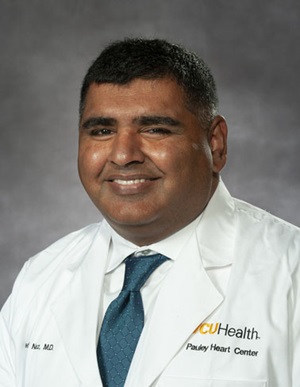
The athlete’s heart health and COVID-19
Return-to-play guidelines and heart inflammation risks for athletes

With running season ramping up this fall, marked by events such as the VCU Health Richmond Marathon, athletes should keep in mind the risks COVID-19 poses to cardiac health, said Naveed Naz, M.D., VCU Health Pauley Center cardiologist and assistant professor of internal medicine in the VCU School of Medicine.
In athletes and non-athletes, COVID-19 infection can possibly cause inflammation of the heart and its lining — or myocarditis and pericarditis — respectively. The conditions occur when a viral infection, in this case COVID-19, has either invaded the heart, or caused an inflammatory and thrombotic cascade, which can lead to heart injury or arrhythmias.

Naz is building Pauley’s sports cardiology program to diagnose and treat heart problems in athletes. Throughout the pandemic, the former military physician has investigated return-to-play decisions for athletes who have contracted COVID-19, and advises athletes training post infection to be mindful of symptoms such as chest tightness and pain, shortness of breath, palpitations and decreased exercise tolerance, which could indicate myocarditis or pericarditis. Athletes who had asymptomatic or minor cases of COVID-19 infection should still ease back into exercise, he added.
“I would say the bottom line is to pursue a staged, common sense escalation back into training,” Naz said. “And if our athletes hit a wall anywhere in that escalation, that’s where they should seek medical attention.”
Though the fit cardio-respiratory systems of athletes may help insulate them from the effects of cardiac and respiratory injury, the condition is still a concern, regardless of the causative virus, Naz said.
“Sometimes that inflammatory piece of heart tissue can be an arrhythmogenic substrate, meaning it can cause arrhythmias in the heart, either atrial or ventricular arrhythmias. So, patients may have palpitations,” he said. “They may even experience cardiogenic syncope; they go into a very fast arrhythmia and pass out.”
Myocarditis has been linked to 10% to 20% of total sudden deaths in young athletes, and COVID-19 myocarditis has been linked to several sudden cardiac deaths in patients who only had mild COVID-19 symptoms. And the extent to which the delta strain and other COVID-19 variants impact the heart is still unknown. Additionally, reports of myocarditis have occurred in those receiving the newer mRNA vaccinations for the SARS-COV2 viruses, although this should not be a reason to avoid vaccines. The benefit of vaccination outweighs the potential risks.
Naz said guidelines on safe return to play published in JAMA Cardiology are a sound reference for physicians and athletes. Individuals with asymptomatic COVID-19 infection are advised to avoid exercise for 14 days from a positive test. For those who experienced mild or moderate symptoms, no exercise 14 days after the complete resolution of symptoms and clinical evaluation is recommended prior to return to play where the doctor will check labs for heart injury, obtain an ECG and an ultrasound of the heart. In both cases, return to play should be gradual. More extensive testing and convalescence before return to play is required for individuals who experience severe COVID-19 symptoms.
A red flag physicians watch for in these athletes is the release of troponin — a protein found in cardiac muscle fibers — into the blood, which could indicate heart injury from heart muscle inflammation or injury. “Troponin is a marker that really exists only inside the heart muscle,” Naz said. “When it is found in the blood, it means that some heart muscle cells have necrosed and released some of this troponin into the blood. So, troponin is a marker for heart muscle injury.”
Overall, careful monitoring, assessment and gradual resumption of activity post COVID-19 infection can keep athletes safe, and the benefits of physical activity outweigh the risks. “In sports cardiology, we want to identify patients who may be at higher risk from certain types of exercise,” Naz said. “We want athletes to return to play, but after COVID-19 infection, we want them to return to full play in a gradual, measured and monitored fashion.”
Back to Autumn 2021


